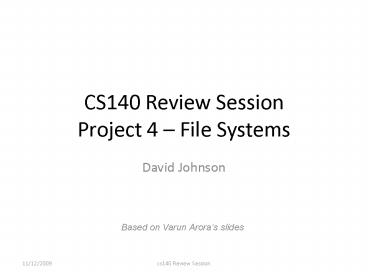CS140 Review Session Project 4 File Systems - PowerPoint PPT Presentation
1 / 14
Title:
CS140 Review Session Project 4 File Systems
Description:
cs140 Review Session. Based on Varun Arora's s. General Points ... cs140 Review Session. 7. Subdirectories. In current FS, all files live in a single directory. ... – PowerPoint PPT presentation
Number of Views:36
Avg rating:3.0/5.0
Title: CS140 Review Session Project 4 File Systems
1
CS140 Review SessionProject 4 File Systems
- David Johnson
2
General Points
- May build project 4 on top of Project 2 or
Project 3 - Up to 5 Extra Credit if built on top of Project
3 - Good News Easier than Project 3
- Not so good news Probably the biggest assignment
in terms of code lines. - Read the Design Document before starting. It will
help you design your project better. - Open ended design
- Like project 3 you have to figure out the design
to get the required functionality.
3
Requirements
- Indexed and Extensible Files
- Subdirectories
- Buffer Cache
- Synchronization at a finer level
4
Indexed and Extensible Files
- Current file system is an extent based file
system. - The size of file is specified at file creation
time. - Continuous sectors allocated on disk for the
file. - It suffers from external fragmentation.
- struct inode_disk
- disk_sector_t start /
First data sector. / - off_t length /
File size in bytes. / - unsigned magic /
Magic number. / - uint32_t unused125 / Not used.
/
5
Indexed and Extensible Files (cont..)
- Modify the on-disk inode structure, to remove
external fragmentation. - Generally some indexed structure of direct,
indirect and double indirect blocks is
used.struct inode_disk - disk_sector_t start / First data
sector. / - off_t length / File
size in bytes. / - unsigned magic / Magic number.
/ - uint32_t unused125 / Not used. /
Data Blocks
Inode
6
Indexed and Extensible Files (cont..)
- Size of the on disk inode structure exactly equal
to DISK_SECTOR_SIZE. - Size of each block is 512B.
- Each block can store 512B/4B 128 block
addresses. - Assume that disk will not be larger than
8MB(minus metadata). - Must support files are large as the disk.
- Dont keep any upper limit on the number of files
which can reside in the FS.
7
Indexed and Extensible Files(cont..)
- Implement File Growth.
- Writing past the EOF should be possible and
should extend the file to that position. - Might need to get additional data blocks and
update the inode data structure. - A read from a position past the EOF should return
zero bytes. - Handle race between a reader reading past EOF and
the writer writing past EOF
8
Subdirectories
- In current FS, all files live in a single
directory. - Directories are files, but have a different
layout. - Consist of an array of directory entries.
- Ensure directories can expand just like any other
file. - Extend the directory structure in directory.c so
that directory entries can be both files and
other directories.
/a/b/
/
/a/
File1.txt
hello.c
a
b
y.c
9
Subdirectories (cont)
- Update existing system calls, to allow relative
or absolute path wherever a file name is
required. - Each process should have a separate cwd.
- May use strtok_r() to parse path names
- Implement new system calls
- bool chdir (const char dir)
- bool mkdir (const char dir)
- bool readdir (int fd, char name)
10
Buffer Cache
File
Inode
Buffer Cache
Disk
- Integrate buffer cache early into your design.
- Similar to VM concept
- Keep a cache of file blocks in main memory.
- Read/Write call must first check the cache and
then go to disk if not present in cache. - Cache is limited to 64 sectors in size.
- Implement a cache replacement policy as good as
clock algorithm ( may give preference to
metadata). - Allowed to keep a copy of the free map in memory
(doesnt count against cache usage)
11
Buffer Cache (cont)
- Write-behind policy
- Dont write the dirty block immediately to disk.
- Flush the dirty blocks when they are evicted.
- Flush the entire cache at a periodical interval
and also in filesys_done(). - Can use timer_sleep from Project 1 for periodic
flushing. - Read ahead policy
- When one block is read, automatically read the
next block from disk. - Should be done asynchronously (can use a helper
thread).
12
Synchronization
- Possibly the trickiest part of the assignment.
- Remove the single file system lock you are
currently using. - Multiple readers can read the same file
simultaneously. - Multiple writers can write to same file
simultaneously. - Their data may be interleaved.
13
Synchronization (Cont )
- Extending a file should be atomic. If A and B
trying to write past the EOF, only one should be
allowed. - Operations on difference directories should be
concurrent. - Operations on same directory can be serialized.
11/12/2009
cs140 Review Session
13
14
Suggested Order of Implementation
- Add buffer cache to existing file system
- All tests from projects 2 and 3 should still pass
- Implement extensible files
- After this, you should pass file growth tests
- Implement subdirectories
- After this, you should pass subdirectory tests
- Everything else
- Remember to think about synchronization during
all 4 steps
11/12/2009
cs140 Review Session
14































